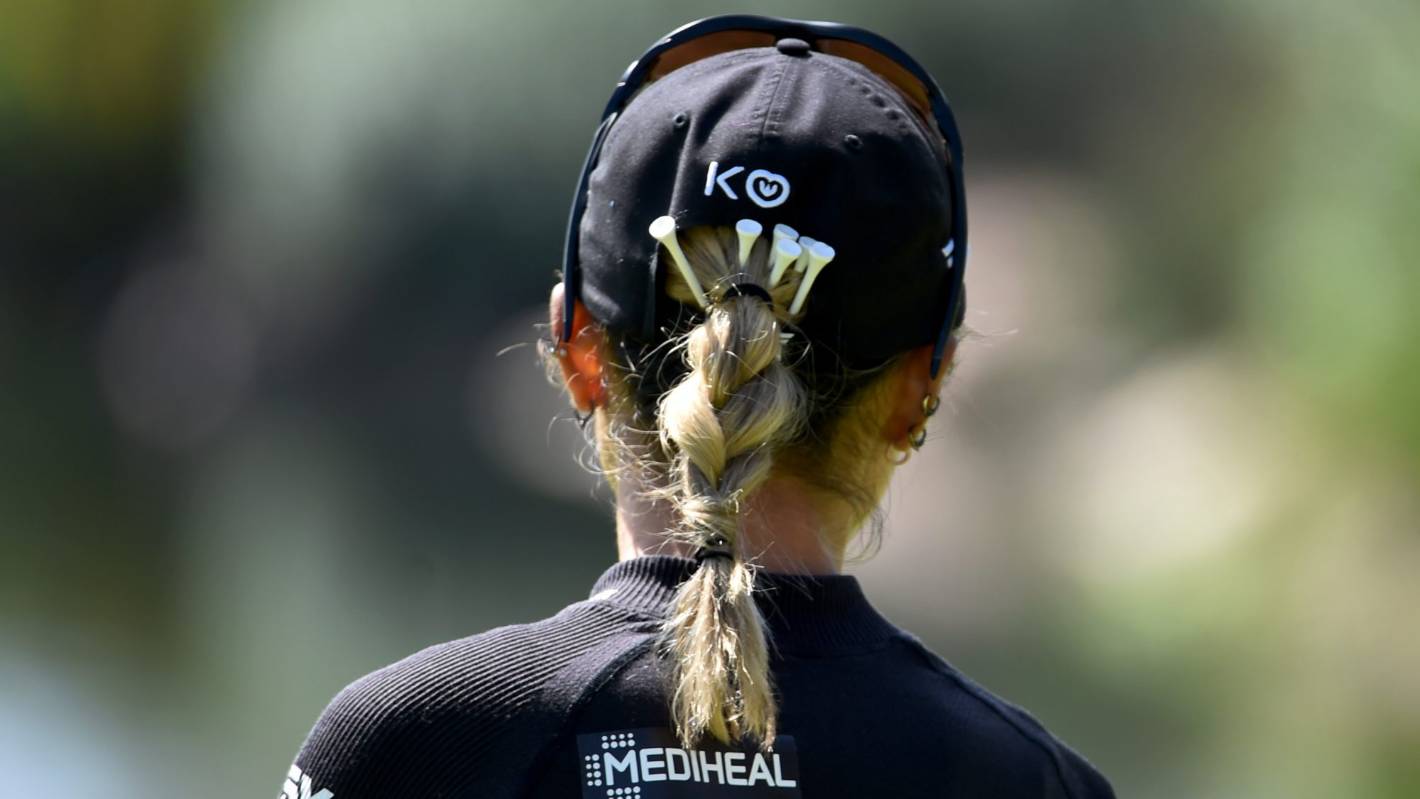What’s up with Lydia Ko? As a bubbly teen she lofted golf trophies so often you feared for her biceps; at 15 she was the youngest to win on the LPGA tour, at 17 history’s youngest world No 1, by 18 the youngest major winner.
But wait, there’s not a lot more: at 22 she is world No 19, hasn’t won in over a year, and yet it still seems just a short putt or so away from when she was sitting on top of the world.
STEVE DYKES/GETTY
Lydia Ko looking ahead, as her supporters vow her best LPGA days are not behind her.
What happened? Short answer: Ko is caught in a perfect storm, with a range of factors putting her into a career water hazard.
Statistically, Ko has been a touch off her best for two seasons; her rivals have improved; golf has turned into a power-hitting game, and Ko is not a power hitter; Asian golfers have swarmed the LPGA Tour, with Korean, Thai and Chinese golfers bringing a depth of talent the Kermadec Trench would struggle to match.
Players hitting the ball further is just where the storm starts – in every statistic except distance off the tee, Ko is not quite as good as in her teens, though still world-class. Her world ranking has held up well in the raging storm: only three players who were in the world top 10 in 2014 remain there, and some have sunk without trace.
While statistics tell much of the story, it is difficult to uncover the rest. Three New Zealand golfers who have played professionally were not keen to comment publicly on Ko’s decline, with two saying it was simply the swings and roundabouts of elite golf, and all three giving variations on “it’s tough out there”.
DAVID CANNON/GETTY
Lydia Ko, caddie Jason Hamilton, sister Sura Ko and mother Tina Hyon in Poppie’s Pond at the 18th green, after winning her second major, the 2016 ANA Inspiration at the Mission Hills Country Club.
Professional Golfers’ Association president Geoff Smart, who has coached top players, is optimistic Ko will rise again, with a variation on “form is temporary, class is permanent”.
“The Lydia story is an interesting one. I am still a believer, as I was with Tiger. Lydia is too talented not to regain her once dominant form,” he says.
In men’s golf, Tiger Woods – with Rory McIlroy and Justin Rose – is one of three in the June 2014 top 10 who are still there, but between times he has made a Phoenix-like recovery from injury and poor form to win the 2019 Masters.
“There are many reasons for her lack of form and slow decline, but I am sure she will shine again,” Smart says.
STUART FRANKLIN/GETTY
Lydia Ko jokes with former swing coach David Leadbetter.
Nor is Team Ko talking. Mid-season is not the time to put such questions to Ko, International Management Group agent Brian Poe has told Stuff.
“Unfortunately, we are not in a position to comment on this story at this time. Statistics and areas of improvement can be determined some time in the off-season (not in the heart of the tournament schedule).” Ko is preparing for the Women’s PGA Championship, starting on Friday.
It is possible even Team Ko can’t put its finger on her slow decline. She has been constantly searching for a coach who fits, from New Zealander Guy Wilson, to Englishman David Leadbetter, to South African Gary Gilchrist, to American-Korean Ted Oh. Now she is coaching herself.
Golfers are inclined to tinker, looking for any edge, yet when you consider the top male players – Woods aside – coaching stability is a given. Caddies (regularly) and her brand of clubs have also changed, with her family backing being the constant she has relied on. Her mother and sister work closely with her.
PHIL WALTER/GETTY
Lydia Ko and her Auckland coach Guy Wilson in 2013.
Working for a family – or someone not inside the golf tour ropes – can be a challenge for any coach or caddy, the experts say. A Ko default has been to look externally for performance gains.
So, with any off-course reasons for her slow decline well out of bounds, let’s ask the statistics to speak to us.
And as far as distance of the tee goes, while Ko has improved her length, her rivals have improved more, so she is further behind now than in 2014. Is that a big deal? It sure is. In golf terms, it’s the root of all evil.
Here’s how a golf specialist with decades of elite level knowledge puts it: “Despite the relative shortness of the LPGA courses, there is no stat in the game that says the closer you get to the hole the worse you get. Those players, men and women, that posses power in the top 25 per cent have a distinct advantage over the other 75 per cent. Lydia Ko is in the other 75 per cent.
YONG TECK LIM/GETTY
Lydia Ko has been on a quest for driving distance.
“Unless you can unpack some seriously good club-head speed with your iron game, you’re going to miss greens … and so on … the game gets more difficult once that starts to happen.”
Shorter drives mean longer approach shots to the green (especially on longer courses used for the majors). Longer approach shots mean missing the target more. Missing the target more means longer putts, having to chip on to the green, or play out of bunkers, then needing to one-putt for par. It puts pressure on every part of the game, and wearying mental stress on a player.
In chasing more distance off the tee, Ko has sacrificed the accuracy that was once her hallmark. So she’s more often closer to the hole off the tee, but in the longer grass, which makes distance control more difficult. Shots out of the rough don’t stop as quickly, so magic is required to get near the flags for a birdie chance.
STEVE DYKES/GETTY
Lydia Ko remains one of the best putters on the LPGA tour.
In one sense, Ko was a pioneer in her own downfall. She showed a generation how to practise, and practise hard. Now there are many more LPGA players keen to elevate their own personal commitment, to practise, to improve.
“Add strength, determination and further sports science into the mix, and it seems the top speed in the fast lane has gotten that little bit faster,” one golf specialist says.
So, it seems Time magazine was right to in 2014 dub Ko one of the world’s 100 most influential people, small consolation when you work like mad all week, only to be beaten at the weekend by a different someone who is that little bit better.
When Ko took the silver medal at the Rio Olympics in 2016, Korean Inbee Park and China’s Shanshan Feng won gold and bronze respectively.
It made for a podium picture credited by some for opening the floodgates for east Asian players – three years on from Rio, eight of the world top 10 are of Asian heritage, with Park (at No 10) the only Olympic medallist among them. Change is also constant at the top, not just at Team Ko.
JONATHAN FERRY/GETTY
Lydia Ko hits out of the sand.
Let’s take a look at the decline and faltering of the Ko empire, comparing her statistically with the LPGA’s 20th-best player in each scoring category.
Make of the numbers what you will, what’s certain is there’s more to the Ko Conundrum to unfold – will talent out in the end?
SCOTT HALLERAN/GETTY
From left, silver medallist Lydia Ko, gold medallist Inbee Park of Korea, and bronze medallist Shanshan Feng of China at the Rio 2016 Olympic Games.
DRIVING DISTANCE
Why it matters: the nearer the green you are after your tee shot, the more likely it is your second shot will hit the target.
Ko: relatively short off the tee. In 2014 she was about seven yards shorter than the 20th-longest driver; now the gap is 22 yards.
Top 20 players: have added about 15 yards to their distance, or three yards a year, with the upward trend stronger than the Kiwi’s.
DRIVING ACCURACY
Why it matters: if you are on the short grass, you have more chance of stopping the ball on the green where you want it (longer grass lessens the spin a player can put on the ball), less likely to be blocked by trees, and have no prospect of being in a fairway bunker – both of which cut down your attacking options.
Ko: known for her accuracy, she hits about eight fewer fairways per four-round tournament in 2019 than she did in 2014, possibly a tradeoff in her search for more power.
Top 20 players: slightly less accurate than in 2014.
GREENS HIT
Why it matters: If you are on the green in regulation (two shots under the par for the hole), you have the prospect of a birdie, or a two-shot par. If you miss the green, you have to chip and must one-putt for a par.
Ko: an outstanding putter, with a superb short game, she is now missing one more green per round than she did in 2014, which raises the odds of her dropping a shot.
Top 20 players: the gap between the 20th-best player on tour and Ko is the widest it has been, with Ko now 5 per cent outside 20th. In 2014, she was 2 per cent better than the 20th player.
PUTTS FOR GREENS HIT
Why it matters: almost half the shots in any round are putts, greens in regulation (GIR) putts are for birdie, birdies win tournaments. Simple.
Ko: she’s a great putter. In 2016, when she was at the peak of her powers, she was almost as likely to take one putt on a hit green as she was to need two. She is still good, yet 2019 is the first year in which she’s been outside the top 20 in this category.
Top 20 players: have improved their GIR putting by 1.8 shots per round, or seven shots per tournament.
PUTTS PER ROUND
Why it matters: putts make up about 40 per cent of any score, with a two-foot putt worth the same as a 250-metre drive.
Ko: Again brilliant, yet not at the level she was in 2016, when she ruled the world.
Top 20 players: have largely trailed Ko, matching her only this year and in 2014.
SAND SAVES
Why it matters: go in a greenside bunker, and you need to get close to the pin to get (“save”) par. Sand saves are a real art.
Ko: generally one of the best on the LPGA, she has been less successful this year.
Top 20 players: one category in which improvement has been steady.
SCORING AVERAGE
Why it matters: obviously the lower score you shoot, the higher up the leaderboard you finish, the more money you win.
Ko: Since 2015 her scoring average has been in steady decline, her average one-round score 1.427 shots higher than it was four years ago – that’s five or six shots a tournament, in many cases the difference between winning or contending, or being an also-ran.
Top 20 players: a slight overall improvement, this year passing Ko for the first time.


















